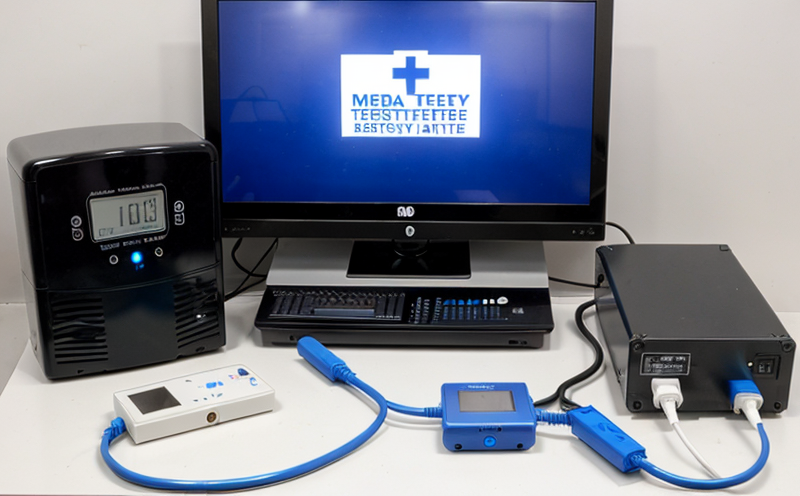JIS C8715-2 Medical Device Lithium-Ion Rechargeable Battery Testing
The JIS C8715-2 standard is a critical guideline for the testing of lithium-ion rechargeable batteries used in medical devices. This Japanese Industrial Standard ensures that these batteries meet rigorous performance, safety, and durability requirements necessary for reliable operation within healthcare settings.
Medical devices powered by lithium-ion batteries are widely used due to their high energy density and long cycle life. However, the high voltage and power capacity of these batteries make them susceptible to various stresses such as overcharging, overdischarging, short-circuiting, and mechanical impacts. Ensuring that medical device batteries comply with JIS C8715-2 is crucial for patient safety and operational reliability.
The testing process outlined in this standard encompasses a range of essential parameters including charge-discharge performance, internal resistance measurement, capacity retention ratio, and the effect of overtemperature conditions. These tests are designed to evaluate how well the battery maintains its functionality under various stress scenarios, which is particularly important for medical devices where reliability cannot be compromised.
During charge-discharge testing, batteries undergo multiple cycles of charging and discharging to assess their capacity retention and efficiency. Internal resistance measurement provides insights into the battery's internal health, helping identify any potential issues early on. Overtemperature tests are conducted to ensure that the battery can withstand elevated temperatures without compromising its performance or causing hazards.
The JIS C8715-2 standard also mandates specific apparatus for conducting these tests accurately and reliably. For instance, precision charge-discharge meters and temperature-controlled chambers are essential tools in this process. Compliance officers and R&D engineers must ensure that their testing facilities are equipped with the necessary instrumentation to meet the standards.
Capacity retention ratio is a key metric used to determine how much of the original capacity a battery retains after extended use or repeated charge-discharge cycles. This metric is crucial for medical devices, as it directly impacts the longevity and performance of the device. By adhering to JIS C8715-2, manufacturers can ensure that their batteries meet these stringent requirements, thereby enhancing product reliability.
The standard also emphasizes the importance of real-world usage notes in testing protocols. For instance, some tests may require simulating specific conditions under which a medical device might be used or stored. This ensures that the battery is tested not just in ideal laboratory settings but also in scenarios that mimic actual field conditions. Such an approach helps to identify potential weaknesses and improve overall product design.
In summary, JIS C8715-2 Medical Device Lithium-Ion Rechargeable Battery Testing plays a vital role in ensuring the safety, performance, and reliability of medical devices powered by lithium-ion batteries. By adhering to this standard, manufacturers can build trust with healthcare providers and patients alike, knowing that their products meet the highest quality and safety standards.
Why It Matters
The importance of JIS C8715-2 cannot be overstated. Compliance with this standard ensures that medical device lithium-ion batteries perform reliably in critical environments, where failure can have severe consequences. Here are several key reasons why adhering to this standard is essential:
Enhanced Patient Safety: Ensures that the battery does not fail during crucial operations.
Increased Reliability: Reduces the risk of unexpected device malfunctions in high-stakes situations.
Regulatory Compliance: Meets international standards, which is often a requirement for market entry.
Better Product Design: Provides insights into how batteries behave under various stress conditions, leading to improved design and performance.
In the realm of medical devices, reliability is paramount. A single failure can lead to serious health risks or even fatalities. By adhering to JIS C8715-2, manufacturers demonstrate a commitment to excellence in product development and quality assurance.
Industry Applications
JIS C8715-2 Medical Device Lithium-Ion Rechargeable Battery Testing is applicable across various sectors within the medical device industry. Here are some key areas where this testing plays a crucial role:
Imaging Devices: Ensures that batteries in MRI machines and other imaging devices operate without interruption.
Monitors: Guarantees that life-critical monitors remain functional during prolonged use and under various environmental conditions.
Life-Supporting Equipment: Verifies the reliability of ventilators, pacemakers, and other life-support systems.
Diagnostic Instruments: Ensures the accuracy and efficiency of diagnostic tools used in healthcare settings.
The testing outlined in JIS C8715-2 is particularly important for devices that are used in critical care units, emergency rooms, or other high-stress environments. By ensuring that batteries meet these stringent standards, manufacturers can provide healthcare providers with reliable equipment that contributes to better patient outcomes.
Quality and Reliability Assurance
The quality and reliability of lithium-ion batteries used in medical devices are paramount. JIS C8715-2 provides a robust framework for ensuring that these batteries meet the highest standards of performance, safety, and durability.
Charge-Discharge Testing: This involves subjecting the battery to multiple cycles of charging and discharging to assess its capacity retention and efficiency. This test is crucial for determining how well the battery can maintain its functionality over time.
Internal Resistance Measurement: This parameter evaluates the health of the battery's internal components, identifying any potential issues early on. A high internal resistance may indicate a need for replacement or further investigation into the cause.
In addition to these technical parameters, JIS C8715-2 also emphasizes the importance of real-world usage notes in testing protocols. Simulating specific conditions under which medical devices might be used or stored helps to identify potential weaknesses and improve overall product design. This comprehensive approach ensures that batteries are tested not just in ideal laboratory settings but also in scenarios that mimic actual field conditions.





